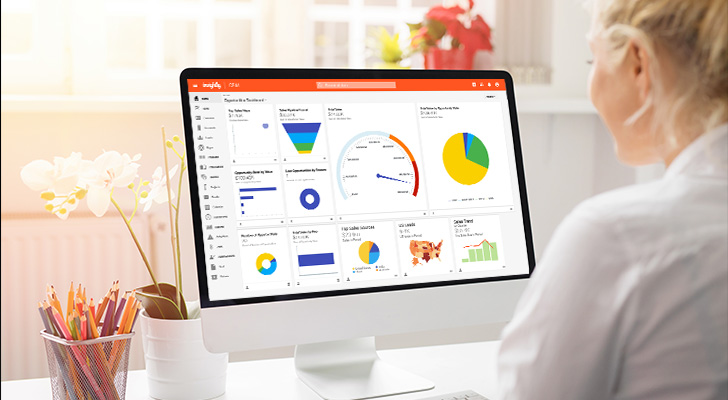Oftentimes, marketers and marketing teams forgo the idealistic for the realistic. We set achievable goals. We taper back expectations. Instead of shooting for the moon, we often shoot for the likelier, but still valuable, stars. This is often what makes marketers great: we know how to maximize wins and minimize losses.
Yet, there is a time when idealism can work for us. In fact, I think creating an ideal customer profile (ICP) for your business is a perfect place to start. An ICP is both an exercise as well as a tool in better understanding your target audience and optimizing your marketing efforts.
What is an ideal customer profile?
An ideal customer profile (ICP) is a comprehensive, documented profile of your company’s perfect customer. While an ICP is relevant in both B2C and B2B marketing scenarios, we’re primarily focused on B2B companies in this article. Ideal customer profiles are crucial for account-based marketing (ABM) and targeting enterprise customers, but a strong ICP also helps you hone any type of marketing campaign and optimize its targeting and messaging.
As a business, it is critical to know what types of customers get the most value out of your products and services. An ICP allows marketers and stakeholders to understand the institutional needs of their target market. With an ICP, marketers can tailor programs to better meet these needs. So, developing an ICP is much easier once you have current customers and you can analyze the data.
Why use an ideal customer profile?
 You could argue that knowing who you sell to is the most important thing to know when you’re building a business, or your marketing plan. In fact it is tied directly to the product and services you offer and whom they benefit.
You could argue that knowing who you sell to is the most important thing to know when you’re building a business, or your marketing plan. In fact it is tied directly to the product and services you offer and whom they benefit.
For example, even a girl with a lemonade stand has a good idea of who she is likely to sell to; people that are thirsty that happen to walk by. She built her business on the premise that she could do this, and then validated it when she began to sell lemonade. As time went by, however, she learned that a true qualifier for her ICP is that most of the time only adults had enough money to buy the product. So, she moved her stand to a more visible place from the road, not just the bike path.
So you can see how knowing who you sell to and why is critical, and also why it makes sense to revisit it over time. That’s a great summary of why you need an ICP.
If you ask any marketer in the world who buys their product, they could probably tell you it’s a set of companies within a certain size range, located in a specific area in the world, who have a need for their product. The problem? Some of these companies might be ideal customers, and some are less-than-ideal. Also, there are other factors to consider such as company situation, growth, resources, current technology stack in place, and more.
So, when you are budgeting for your go-to-market efforts, you want to focus on the best match for not only who could use your product, but who is most likely to use it as intended and get long-term value from it. Marketers can use an ICP to understand the full customer journey and find a stronger product-customer fit.
What is an ideal customer?
Sometimes, what may seem like an ideal customer, may not in fact serve your business. For example, say you have one extremely high-revenue customer. They are loyal and they pay you the equivalent of 50 smaller customers. Great, right?
But, say this customer takes up 80 percent of your server bandwidth. They have a half-dozen dedicated account managers. They need round-the-clock customer support. Is this your ideal customer? Would you want to replicate this customer 100 times over? No. Your ideal customer needs to be manageable, and one that would allow your company to scale and thrive.
It can be easy to have dollar signs in your eyes when thinking about your ideal customer. In this case, it’s important not to equate the biggest invoice with the best value.
An ideal customer is one that experiences customer satisfaction. That customer is profitable, scalable, and a long-term fit for your business growth.
How do you create an ICP?

There are six steps to create an ideal customer profile. Use this list as an ideal customer profile template:
1. Collect customer data
Start with what you already know. Consult data collected through your customer relationship management system (CRM), customer data platform and other analytics tools. This will begin to illustrate the quantitative trends in your target market.
You may want to use a spreadsheet or business intelligence (BI) solution to layer your customer data. This will allow you to identify trends and note your ‘best’ customers and the ideal buyers within your customer base.
2. Talk to your customer-facing teams
You likely have employees that talk to your customers every day. They might be in sales or customer success, but either way they’ll have a good idea based on their daily interactions who is most likely to buy and get value from your products or services over the long term. What type of customer is happiest? What type of customers achieve ROI the quickest? What types are likely to add on to their subscriptions and renew their business with your organization?
You can’t develop an effective ICP in a vacuum. Your product team will have a role, but talking to your customer-facing teams is vital. This important, qualitative data will be helpful, in addition to collecting other data from your CRM about potential buyers.
3. Identify ‘ideals’ in your customer data
When combing through your data, note some of the traits of your best, most valuable customers in your current customer base. Those may be tied to revenue, customer acquisition cost, customer lifetime value, and/or sales cycle length. Get a detailed description.
Once you identify the categories, get specific. Is your highest-revenue customer $10,000/year or $100,000/year? Were they expensive to acquire? Did they have the longest or shortest sales cycle?
Answering these questions about customer engagement decisively will paint a picture not of a customer, but of the ideal customer.
4. Document customer traits & demographics
Identify the things that you can see about your ideal customer (also known as your target customer). These might be their:
- Industry
- Location
- Key decision-makers
- Company size: Possibly measure in number of employees or annual revenues
- Corporate structure (corporations, partnerships, etc.)
Some decide to break into broader areas as they are building their ICP. This might be useful to add clarity and specificity to your ICP documentation. These categories include:
Firmographics:
Whereas demographics describe a group of people, firmographics describe the characteristics of a group of organizations. These characteristics might include:
- Industry (or SIC code)
- Company size (employees and/or revenues)
- Geographic Location (Country, State, City, etc.)
- Key Roles and decision makers (C-level, IT, Operations, Sales, Marketing, CX, etc.)
Technographics:
Sometimes it is helpful to know what types of technologies are used in your ICP. For example, do they use a certain accounting tool, or do they utilize a certain analytics tool. Having this data is often more important for tech or software companies to identify common “marker” software that might indicate they also have a need for your product.
For example, say your firm sells eCommerce software and about 50% of your current clients come from businesses that also use a specific ERP software. That indicates this technographic item is an important consideration for your ICP, because the ability to know that a firm has this ERP technology becomes important as you choose your target.
Psychographics:
If businesses can have a certain psychology, it would be demonstrated in how and why they might buy your product. For a B2C example, you might find that your health tracking software primarily appeals to those that have certain health history, or personal goals and track record around using products and services that indicate the desire for a healthy lifestyle.
Businesses can have similar drivers based on their experiences that lead them to having affinity in a certain segment. In B2B, for example, if a company has always struggled to grow, they are more likely to be open to new growth products and services that can help them drive revenue.
Corporate Structure / Operating Model & Resources:
Looking at this can be especially helpful in honing detail into your ICP because it is focused on other key elements of your target companies. For example, are you focused on sole proprietors and start-ups or late stage public corporations? Is your product expensive and might only appeal to companies with significant resources? Are you targeting single product line business, or diversified conglomerates? Similarly, is your target market companies that are in a growth mode, or those that are in a cost cutting mode?
It is important to articulate all of these types of company characteristics in your ICP documentation as all of them impact an organization’s needs for your products and services as well as their willingness and capability to buy them.
-
Research the ‘unknowns’ about your ideal customer
You know how your customer interacts with your company. Yet, that’s one small piece of who they are.
Here are a few questions you can ask of your best customers when building an ideal customer profile:
- What was the pain point that led you to seek out our product?
- What are your company’s other pain points or immediate needs?
- Who at your company benefits most from using our product?
- What other B2B solutions does your company use?
- What is the outlook for your company and industry over the next few years?
6. Detail how your company helps your ideal customer.
So far, you have created a great ideal target account profile. How do you turn it into an ideal customer profile?
Document how your product serves your ideal customer. Your new understanding of their business should make this exercise clear. How does your product solve their pain points, and how will that continue into the future? Are those pain points resolved instantly, or do they resolve over a certain period of time. Does your product or service fulfill an ongoing need for the customer, and how can your offering extend to meet more needs and address more pain points?
Document your findings in an ICP document
Once you’ve completed your research, combine your findings into your final customer profile. It should paint a picture of the exact company you’d like to have using your product with great detail. This will guide your digital marketing and sales teams on whom to target. It’s a key part of your overall marketing strategy. It will guide your sales pitch, sales strategy, and business goals.
Also, it is very important to do the work to validate this with your team and sales reps and present it to all key departments that either make the products that you sell, or actually market, sell and deliver them. This is likely most of your company, and is most certainly your go-to-market teams.
Once it is ready, put it into a presentation and cover it with all of those teams. Also, revisit this information at least yearly or if there are important changes and updates to your company or to the markets you serve.
Here’s an example of how you could structure a summary of your ICP document:
| Data Type | Ideal Customer Profile |
| Firmographics |
|
| Technographics |
|
| Psychographics |
|
| Corporate Structure / Operating Model & Resources |
|
Ideal customer profile vs. buyer persona
Modern marketing programs rely on buyer personas, or fictionalized versions of potential customers. If you are selling a manufacturing product, your buyer personas may be ‘Project Manager Pam,’ or ‘Budget Owner Bob.’
Buyer personas are useful when using buyer enablement marketing on a personal level. XYZ Manufacturing is not going to click on your LinkedIn ad or read your blog post, but Project Manager Pam might.
Ideal customer profiles zoom out from buyer personas. They are a holistic look at the entire firm, rather than the pain points of the individual decision maker. Ideal customer profiles and buyer personas are best used in concert with one another.
ICP vs. TAM, SAM, SOM
You might be wondering how ICP differs from other popular acronyms used to help size markets. TAM, SAM, and SOM are often used, primarily in financial discussions of market sizing. However, while they are tangentially similar to ICP, they are not the same.
What is TAM (Total Addressable Market)?
This represents the hypothetical total market that your company could serve. It is often bigger in theory, rather than reality, which is why you need the other descriptors.
What is SAM (Serviceable Addressable Market)?
This is the portion of the TAM that a business can realistically hope to service, based on their location, size, resources, and capabilities. Often this is not time-bound, so also somewhat hypothetical.
What is SOM (Serviceable Obtainable Market)?
This represents the portion of the SAM that you can expect to realistically obtain via go-to-market activities in a short period of time.
ICP is different from TAM, SAM and SOM in that ICP focuses on defining the companies that are the best fit for your business and are most likely to derive ongoing value from your product and services.
How can you use an ICP?

The modern B2B marketing and sales process relies on a true understanding of the target market. An ideal customer profile can influence these revenue programs in several ways:
Improving your account-based marketing
An ideal customer profile serves as a template for an account-based marketing (ABM) target account list. Your account-based marketers can use an ICP as a template for finding potential customers. These can form the target account list for an ABM campaign.
Improve MQLs & SQLs
Use your ideal customer profile to qualify leads into Marketing Qualified Leads (MQLs) and Sales Qualified Leads (SQLs). Your MQL and SQL criteria should align with your ICP and personas. If a lead is less than 50 percent similar to your ideal customer, you can confidently take them out of your funnel. You can also use a rubric to compare leads against your ICP. By doing this, you focus on moving along leads that have the potential to be your best customers.
Improve your product-market fit
Your ICP may have revealed that your ideal customer has needs that you are not meeting. This profile can identify gaps in your product-market fit. These gaps are opportunities to innovate your product and/or offer additional, companion products. This is the beginning of your upsell/cross-sell motion which makes your company stronger This can lead to better, longer-term customer relationships.
Develop your ideal customer profile today
An ICP is an essential part of your go-to-market motions and will serve as a guide post for your go-to-market teams. The time you invest in developing it may seem daunting, but you’ll gain so much clarity by having it that you won’t regret the investment.
Already have an ICP? Revisiting an ideal customer profile can refresh your digital marketing and sales focus. By completing this exercise, you can renew your focus on bringing in the best customers for your company’s growth.
Once you have an ICP established, you’ll have your marketing automation platform full of prospects that will quickly become opportunities in your CRM. In the market? Choose a platform that’s modern, affordable and easy to use – Insightly. You can start a free trial, watch a demo-on-demand, or set a time for a personalized demo with the Insightly team.



